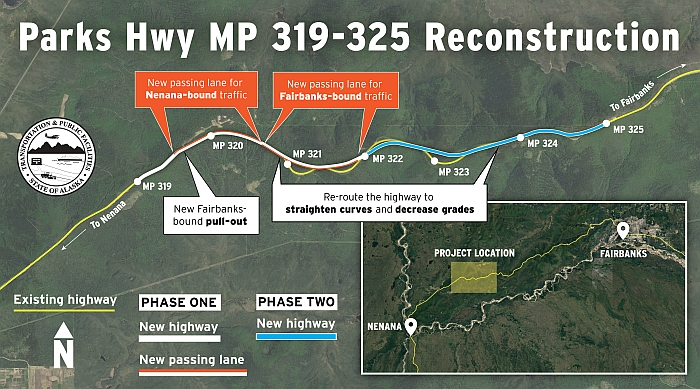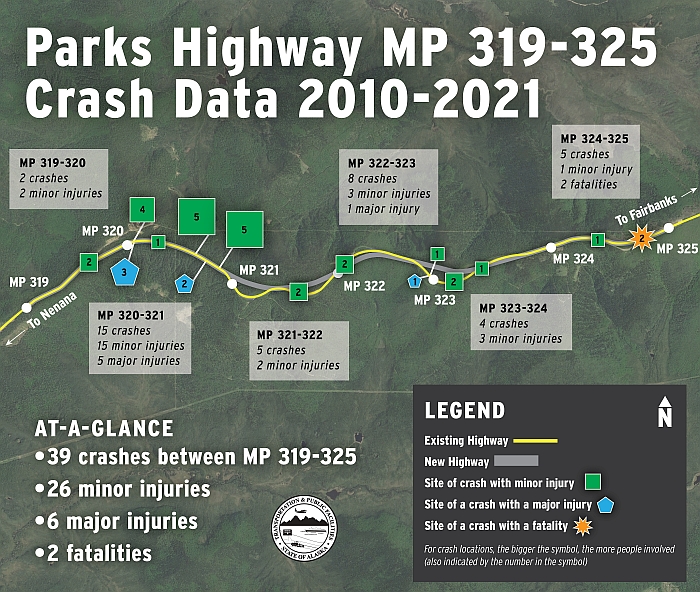Parks Highway 319-325 Reconstruction
Project No. Z606570000/0A45028
The Parks Highway between mileposts (MPs) 319 and 325 (in the hills between Nenana and Fairbanks) does not meet current engineering standards and needs to be upgraded. The project team at Alaska DOT&PF is working to reconstruct this section of highway to improve safety and better serve today’s travelers. The earliest construction could start on this project is 2025 and it will take several years to complete.

Map showing the project location, new highway alignment, and key project features
Why is this project needed?
The section of the Parks Highway between Nenana and Fairbanks was originally built in the 1950s. It was upgraded in 1967, then rehabilitated with additional truck lanes in 1985. Since that time, only regular maintenance and minor upgrades like the addition of signs at curves has occurred.
The highway is now in poor condition, requires extensive maintenance from our road crews, and has steep hills with sharp curves that don’t meet current engineering standards. Drivers turning into traffic from several pull-outs and driveways have limited line of sight into oncoming traffic, few passing opportunities create delays, and the ground beneath the distressed pavement is so poor that we have to impose weight restrictions in the spring.
We are also seeing crashes along this corridor that are more frequent at the sharpest curves, further evidenced by the fact that our maintenance crews frequently have to replace guardrail due to vehicle collisions. Crash severity over the last decade has ranged from vehicle damage and minor injuries to six major injuries and two deaths among travelers of this corridor.

Map showing locations and severity of crashes within the project area between 2010 and 2021
What does the project include?
The most significant work on this project includes straightening curves and flattening hills and dips to meet current engineering standards for a highway of this type. This will require extensive excavation and fill and will result in a modern highway that better serves all travelers, from commercial vehicles to cyclists.
In addition to the work on hills and curves, improvements include:
- Construction of new passing lanes
- Upgrades to current passing lanes and truck lanes
- Improvements to and lengthening of the pull-out at mile 319
- New snow plow turn-around locations
- Construction of 8-foot shoulders to accommodate cyclists
- Drainage improvements include culvert work and ditching
We expect these improvements will result in:
- Fewer crashes and injuries
- An average increase in traveling speed
- Smoother driving surface
- Removal of spring weight restrictions
- Improved sight-distance at driveways and pull-outs
- Reduced maintenance costs
How did you make decisions?
We conducted public outreach, including a public meeting in 2018, to gather input from landowners, commercial vehicle operators, highway users, and our own maintenance teams. The feedback we received, along with computer modeling, helped us identify issues with the current highway and work out details like where to locate passing and truck lanes. You can view the public comment summary and other outreach documents on our document page.
In addition to public feedback, we considered the following when making decisions about the highway design:
- Traffic operations
- Safety
- Utility impacts
- Environmental impacts
- Freight operations
- Right-of-way impacts
- Constructability and traffic control during construction
- Construction costs
- Maintenance considerations
What is the schedule?
The project team is currently developing the final design, which includes highway realignments, new passing and truck lanes, and drainage improvements.
We are using the Construction Manager / General Contractor (CMGC) procurement method, which involves bringing the construction contractor on board during project design to work through construction-related risks, issues, and opportunities early in the process. The CMGC contract was awarded to Granite Construction Company for preconstruction services.
The earliest we expect construction to begin is 2025, and we expect it will last several years. The schedule below shows the work that has been completed and what we expect over the next several years, dependent on funding availability.

Project Information
Contact Information
For more information, contact:
Jennifer Wright, P.E.
DOT&PF
Engineering Manager
2301 Peger Rd Fairbanks, AK 99709-5316
![]() Jennifer.Wright@alaska.gov
Jennifer.Wright@alaska.gov
For individuals requiring TTY communications, please contact Alaska Relay at 7-1-1 or 1-800-770-8973.
The environmental review, consultation, and other actions required by applicable Federal environmental laws for this project are being, or have been, carried out by DOT&PF pursuant to 23 U.S.C. 327 and a Memorandum of Understanding dated April 13, 2023, and executed by FHWA and DOT&PF.
PLEASE NOTE: Adobe Acrobat PDF files require a free viewer available directly from Adobe.
